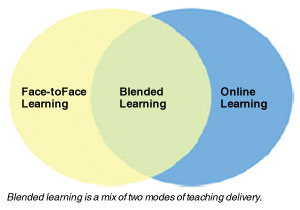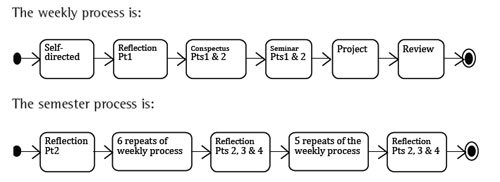|
by Kevin Anthony Jones
  ecturing has been the mainstream form of teaching in universities since they were first established. So, it is a cause of great concern when students appear to be rejecting it-and they are doing exactly that, in droves. The decline in lecture attendance has become so widespread and so significant, that academic committees in many schools are being formed just to address this one issue. The usual suspects for low attendance in lectures are an inadequate teaching acumen in the faculty and academically-substandard students. But the truth of the issue goes beyond the capabilities of the respective participants - it involves learning theory, educational philosophy, psychology, and sociology. Unfortunately, many universities seem unable or unwilling to introduce any change to lecture-driven teaching, perhaps because of the resources and brand investments that they have made. Thus, it behooves the individual faculty to innovate, making their teaching and learning more effective. To this end, the following is a new and innovative yet feasible teaching and learning approach that can be applied in Asia Pacific universities. ecturing has been the mainstream form of teaching in universities since they were first established. So, it is a cause of great concern when students appear to be rejecting it-and they are doing exactly that, in droves. The decline in lecture attendance has become so widespread and so significant, that academic committees in many schools are being formed just to address this one issue. The usual suspects for low attendance in lectures are an inadequate teaching acumen in the faculty and academically-substandard students. But the truth of the issue goes beyond the capabilities of the respective participants - it involves learning theory, educational philosophy, psychology, and sociology. Unfortunately, many universities seem unable or unwilling to introduce any change to lecture-driven teaching, perhaps because of the resources and brand investments that they have made. Thus, it behooves the individual faculty to innovate, making their teaching and learning more effective. To this end, the following is a new and innovative yet feasible teaching and learning approach that can be applied in Asia Pacific universities.
The new and innovative approach is not untried and unproven, not imbued with unwieldy technology, and not completely disassociated with familiar and trusted practices. This approach supplements not supplants, the traditional face-to-face (F2F) culture of university teaching. All that it requires is a fresh perspective of professorial obligations and objectives, the courage and resolve to deal with all the problems arising from a change of practice, and the time to conceptualize and build the approach artifacts.

The approach is blended learning, and a fully functional 13- week version of it has been in operation in the School of Computer Engineering (SCE) since 2008. This blended learning intervention was awarded a Teaching Excellence Fund grant in 2009, and its results are reported to NTU management. Essentially, it has a strong endorsement from the students who went through it; the majority view is that more subjects in the university should be delivered as blended learning. The rest of this article will discuss how to plan, design, and implement a similar version of blended learning in your subject.
Blended learning is based on a deceptively simple premise: a purposeful mix of two modes of educational intervention, i.e., face-to-face (F2F) and eLearning, in the one subject. The F2F mode provides observational and social learning, while the eLearning mode provides experiential and behavioral learning. Being a mix, each mode is separately conducted from the other, and their individual strengths are retained, not diluted. Thus, their seamless integration magnifies learning beyond their individual extents. Given all of this, are you interested in putting blended learning into practice for your subject? If so, how do you proceed?
For a first time adoption of the Asia Pacific blended learning approach, the methodology can be reduced to these 6 simple steps:
- Decide on the F2F-eLearning mix ratio, and calculate the hours assigned for each mode.
- Rethink the primary characteristics of your subject's learning space.
- Brainstorm activities in each of the two modes that best promote the characteristics of your subject's learning space.
- Design the learning process that sequences these activities for your subject.
- Run a pilot of your blended learning design, and solicit feedback.
- Action the feedback, and relaunch your blended learning design as a finished product.
Ratio and Hours
The ratio of the mix is 60% F2F and 40% eLearning. Asian-educated students are presently brought up in a more paternal learning culture, so the majority weighting for the F2F mode better fits their needs. The hour breakdown per mode is calculated on an NTU-standard weekly basis of 9 hours-the traditional lecture-driven subject has a total of 6 hours of F2F mode with students, comprising 3 hours for lectures, 1 for tutorial, and 2 for lab. Additionally, the students are expected to put in up to 1 hour of preparation per lecture. Therefore, the mix ratio translates into 5 hours of F2F and 3 and one-half hours of eLearning.
Learning Space
This is unique for every subject, depending a lot on the curriculum, practices, and available educational resources. In the SCE version, the main learning theories followed are cognitive and problem-based (PBL). For cognitive learning, the resources are tailored for most of the Felder-Silverman index learning preferences; there are up to 14 different mediums of learning resources for every topic in the subject. For PBL, the students are assigned to a study team for the duration of the subject. Hard/technical, soft/interpersonal, and critical thinking are the 3 desired learning outcomes. Formative assessment is used to identify progress, and summative assessments are used to measure participation and performance. Heavy use is made of educational technology that aids both the student and the professor, including clickers, LAMS software, video, Internet, multimedia classrooms, and social networking systems.
Learning Activities
The SCE blended learning has all-new activities - lab, lecture, and tutorial are replaced - to accommodate the characteristics of the learning space. This is the choice of the professor; it is not a requisite of blended learning. In other words, familiar activities may be retained. However, due consideration must be given to introducing the eLearning component, which means some of the original F2F activities have to be shortened.
The new activities in the SCE version are:
- Conspectus - to demonstrate a broad knowledge of the topic. It is conducted in 2 parts. The first is eLearning, with the student submitting a written abstract of the topic, not greater than 250 words, and receiving feedback. The second is F2F, with the student preparing and participating in his/her study team presentation of the solution for a confirmation question on the topic.
- Project - to apply hard, soft, and critical thinking skills in a realistic scenario. This is a re-envisioning of the lab, and retains its F2F modality. The student works in his/her study group to build a subsystem that integrates with other subsystems built by other study groups to carry out the collaborative mission of the overall system.
- Reflection - to enhance and optimize the process for learning. It is conducted in four parts. The first is eLearning, with the student making a declaration of his/her learning progress and challenges for the week. The second is also eLearning, with the student critically analyzing the factors influencing his/ her learning intrinsic characteristics. The third is F2F, with the student engaging in a group discussion of their learning progress, challenges, and characteristics. The last is also F2F, with the student undergoing two summative assessments of the topics for half a semester.
- Review - to measure individual learning performance. In a F2F session, the student undertakes a 10-question MCQ using clickers, sees his/her peers' answers, and receives feedback.
- Self-directed - to achieve initial learning of the foundation concepts and heuristics of a topic. In an eLearning mode, the student undergoes a formative assessment of present knowledge, discovers the topic in several small and logical segments, undergoes another formative assessment to confirm the learning and ends with a practice assignment to reinforce the learning.
- Seminar - to demonstrate a deep knowledge of the topic. It is conducted in two parts. The first is F2F, with the student preparing and participating in his/her study team presentation of the solution for a critical thinking question given on the spot. The second is eLearning, with the student challenging the soundness of other study teams' posted solutions and also defending the soundness of his/her study team's own solution. Both parts are provided with feedback.
Process Design
 The instructional design used for the SCE blended learning is the Attention, Relevance, Confidence, and Satisfaction (ARCS) motivational model. The overall design has a weekly process and a semester process. The instructional design used for the SCE blended learning is the Attention, Relevance, Confidence, and Satisfaction (ARCS) motivational model. The overall design has a weekly process and a semester process.
Most importantly, the weekly process only requires 5 hours, not 6, so that time can be returned to the student for eLearning. The assignment of days of the week for the F2F activities is flexible. A typical timetable has:
- Conspectus part 2 - Tuesday
- Seminar part 1 - Wednesday
- Project - Thursday
- Review - Friday.
Given the above, the Self-directed, Reflection part 1, and Conspectus part 1 are over the prior weekend. Seminar part 2 goes from Wednesday to the end of week, and this weekly process then repeats for the next week. Parts 2-4 of the Reflection activity take the entirety of weeks 7 and 13. The final exam routine continues as per normal.
In summary, individual faculty will have to take the initiative to address the seeming rejection of the lecture-driven teaching approach. One way to do so is through blended learning, and a home-grown version has been operating in NTU for 4 years. The methodology for developing a blended learning approach can be done in only 6 steps. While the SCE version of the blended learning has all-new learning activities, each professor is empowered to conduct traditional or familiar activities as long as the eLearning mode is present. Always remember, learning is a process that needs the guidance of a teacher, but also the engagement of the learner!
 Click here to download the full issue for USD 6.50 Click here to download the full issue for USD 6.50
|



 ecturing has been the mainstream form of teaching in universities since they were first established. So, it is a cause of great concern when students appear to be rejecting it-and they are doing exactly that, in droves. The decline in lecture attendance has become so widespread and so significant, that academic committees in many schools are being formed just to address this one issue. The usual suspects for low attendance in lectures are an inadequate teaching acumen in the faculty and academically-substandard students. But the truth of the issue goes beyond the capabilities of the respective participants - it involves learning theory, educational philosophy, psychology, and sociology. Unfortunately, many universities seem unable or unwilling to introduce any change to lecture-driven teaching, perhaps because of the resources and brand investments that they have made. Thus, it behooves the individual faculty to innovate, making their teaching and learning more effective. To this end, the following is a new and innovative yet feasible teaching and learning approach that can be applied in Asia Pacific universities.
ecturing has been the mainstream form of teaching in universities since they were first established. So, it is a cause of great concern when students appear to be rejecting it-and they are doing exactly that, in droves. The decline in lecture attendance has become so widespread and so significant, that academic committees in many schools are being formed just to address this one issue. The usual suspects for low attendance in lectures are an inadequate teaching acumen in the faculty and academically-substandard students. But the truth of the issue goes beyond the capabilities of the respective participants - it involves learning theory, educational philosophy, psychology, and sociology. Unfortunately, many universities seem unable or unwilling to introduce any change to lecture-driven teaching, perhaps because of the resources and brand investments that they have made. Thus, it behooves the individual faculty to innovate, making their teaching and learning more effective. To this end, the following is a new and innovative yet feasible teaching and learning approach that can be applied in Asia Pacific universities.

 The instructional design used for the SCE blended learning is the Attention, Relevance, Confidence, and Satisfaction (ARCS) motivational model. The overall design has a weekly process and a semester process.
The instructional design used for the SCE blended learning is the Attention, Relevance, Confidence, and Satisfaction (ARCS) motivational model. The overall design has a weekly process and a semester process.
 Click here to download the full issue for USD 6.50
Click here to download the full issue for USD 6.50